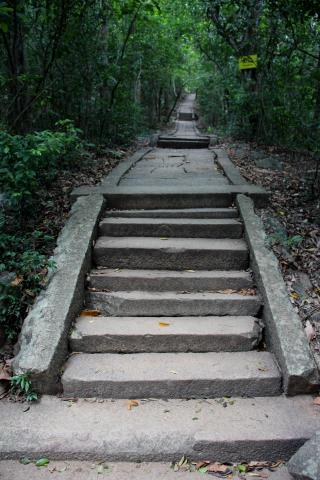Ritigala Strict Natural Reserve
An isolated hill, stands out as a prominent erosion remnant, rising from 180 m to 768 m above the surrounding peneplain, providing home to three (3) floral species and one (01) fauna species no elsewhere in the world. (Point endemic species)
This isolated hill, 6.5 km in length, is divided into northern and southern blocks by the shallow
Maha-Degala gorge. Malwatu Oya originates from this area, flows towards north-west and ends its journey at Gulf of Mannar. It is most important water catchment area in the north-western Dry Zone. Na Ela and Deva Ela begin from this area other than Malwathu Oya.
This landscape was declared as Ritigala Strict Natural Reserve on 7 November 1941 (Gazette Notification No. 8809), having an area of 3,776 acres and 34 perches (1,528.2 ha). Hence Ritigala is one of the three Strict Natural Reserves has been declared under the provisions of Fauna and Flora Protection Ordinance. As 1a of IUCN protected area category (Strict Nature Reserve), human visitation, use and impacts are strictly controlled and limited in these areas to ensure protection of the conservation values. These areas are reference areas for monitoring of changes in outside due to the human impact and create unique habitats for endemic species (Point endemic). Entering into the Ritigala SNR is prohibited. But it is not restricted for the purpose of discharging any official duty or authorized scientific research. Both purposes can be deployed along with the permission of the Director General of Department of Wildlife Conservation.
Climate
The Tropical Dry hot Monsoon climate is characterized by: a bimodal pattern of rainfall; uniformly high temperatures through the year (mean = 27.3 o C); a protracted dry period prior to the main rainy season (October-January) during the north-east monsoon (Maha); and desiccating winds during the long, hot south-west monsoon (May-September) that subject the vegetation to severe moisture stress. Rainfall peaks in April-May (Yala season) and October-November; total annual rainfall ranges from 1470 mm in the north to 1500 mm in the south.
Biodiversity
Flora – 417 taxa of lower and higher plants were recorded from the SNR. It consists with 337 flowering plants of which 57 are endemic to Sri Lanka. Four taxa namely Madhuca clavata, Coleus elongates (syn. Plectranthus elongates), Dendrocalamus cinctus and Thunbergia fragrans var. parvilora are endemic to Ritigala. (Jayasooriya 1984).
Fauna – Cnemaspis retigalensis (Retigala day gecko), a newly described endemic species distributes only in Ritigala, is common in the Dry Mixed Evergreen Forest and Short-Stature Forest.
Vegetation/ Habitat Types
Vegetation Types such as Dry mixed evergreen forest, Disturbed Dry mixed evergreen forest, Short – Stature Forest, vegetation associated with Rock Outcrops, Scrub have been identified in the SNR.
The vegetation shows a clear pattern of altitudinal zonation. Most of the wet zone species are found at higher elevations and some of them are strictly confined to the summit areas of the Ritigala. Some species occur more or less in sharp altitudinal zones. Most of the dry zone species are restricted to lower elevations. A Short- Stature occurs on the summits and upper slopes of Ritigala.
History
According to mahawansa and Chulawansa , during 187 -177 B.C. king Surathissa built Sanka Viharaya (Lanka Viharaya) at the base of Ritigala mountain. During 59 -50 B.C. , king Lajja thissa built Aritta Viharaya in Ritigala. The chronicles further state that prince Jetti thissa and prince Pandukabaya used Ritigala to organized their armed forces.
Seventy four rock caves with carved drip – ledges on the top of them, 152 inscriptions and 140 archeological remains found in Ritigala and its surrounding area are the evidence to ancient Ritigala. It was a sacred Buddhist monastery where first Lankan “Arahath Bhikku” Aritta lived.
Visitor Attractions – Not considered.
Visitor Facilities – Information and Research centre is located in Keeriyagaswewa.
Access Road – It lies in Anuradhapura District just to the north of the A11 Highway between Habarana and Maradankadawala from where it is accessible road the west via Ganewelpola or east from Galapitagala.
Source - https://www.dwc.gov.lk/

